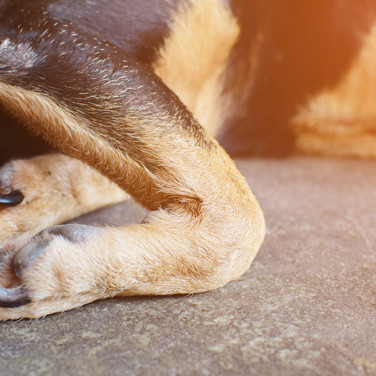DISEASES
Malassezzia Dermatitis in Dogs - Treatment for Canine Yeast Dermatitis
페이지 정보
본문


What is Malassezia dermatitis in dogs?
Malassezia dermatitis is a skin disease in dogs caused by the yeast Malassezia pachydermatis, a type of fungus that is normally present on the skin. However, when this yeast grows abnormally and excessively, it leads to inflammation and dermatitis on the skin. Treatment for Malassezia dermatitis depends on the severity of symptoms and usually involves the use of topical or oral medication. In the case of an underlying cause, treatment for the condition will be administered first. Malassezia dermatitis in dogs is one of the most common skin diseases in dogs, and early detection and appropriate treatment are crucial for effective management for a better quality of life.
Common causes of Malassezia dermatitis in dogs
The skin is home to numerous bacteria and fungi which are typically well regulated by the body's immune system. However, when skin conditions change or the immune system is weakened, infections can occur. Malassezia dermatitis is one of those infections where the yeast thrives and causes a spread of infection.
Malassezia dermatitis is more likely to occur in wet and oily skin, particularly in cases of allergic skin disease where the skin barrier is weakened and scratching causes the skin to break. Similarly, excessive licking creates a moist environment on the skin which can create an ideal environment for bacteria to grow. Dogs with oily seborrheic dermatitis are also at a higher risk for Malassezia growth due to their oily skin.
It's important to note that Malassezia dermatitis is not contagious and cannot be transmitted from one dog to another.
Underlying causes that can cause Malassezia dermatitis in dogs include:
-
Allergic skin disease
Allergy-related health issues such as atopy, food hypersensitivity, or flea bite hypersensitivity can lead to Malassezia dermatitis.
-
Seborrheic skin disease
As explained before, oily skin allows yeast bacteria to grow exponentially.
-
Systemic disease
Systemic diseases that weaken the immune system, can lead to chronic yeast infection because the immune system is suppressed. A compromised immune system makes it harder for the body to fight off infection.
-
Endocrine disease
Diseases that affect a dog’s endocrine system such as hypothyroidism, Cushing’s Cushing’s disease, and diabetes can lead to the growth of bacteria on the skin.
-
Immunosuppressive drugs
Immunosuppressive drugs such as corticosteroids can prevent a dog’s immune system to be unable to effectively prevent yeast infections from worsening, leading to chronic yeast infections.
-
Skin folds and humid environments
Yeast bacteria thrive in wet, warm, and humid environments. Dogs with many skin folds or a humid environment are ideal breeding grounds for bacteria that can cause Malassezia dermatitis.
Symptoms of Malassezia dermatitis in dogs

Malassezia dermatitis is a skin condition that commonly manifests between the toes, in the lower neck, under the armpits, around the anus, in the external ear canal and folds, as well as around the mouth. Pay attention to these areas to catch the early signs of dermatitis for quick treatment and a better prognosis.
Common symptoms of canine Malassezia dermatitis include:
- Itchy skin
- Skin redness
- Scaling and crusting
- Greasy discharge
- Thickened skin
- Hyperpigmentation
- Bad smell on the skin
- Chronic or recurrent otitis externa
- Nail infection and brown discoloration of hair around nails
Risk of Malassezia dermatitis in dogs
The following breeds are genetically prone to fungal yeast infections:
- West Highland White Terrier
- Basset Hound
- Cocker Spaniel
- Silky Terrier
- Australian Terrier
- Maltese Terrier
- Chihuahua
- Poodle
- Shetland Sheepdog
- Lhasa Apso
- Dachshund
- Shih Tzu
- English Setter
- Boxer
How to treat Malassezia dermatitis in dogs at home
If your dog is showing signs of dermatitis, such as excessive biting or licking due to itchiness, it is recommended to use a neck collar to prevent their skin or condition from worsening. If symptoms persist or worsen, it is ideal to consult a veterinarian for an accurate diagnosis as early as possible.
Diagnosing Malassezia dermatitis in dogs

When you visit the hospital for a skin problem on your dog, your veterinarian will inquire about the onset of the issue, the severity of the itching, and examine any potential underlying medical conditions or medications your dog may be taking.
Following this, the following skin tests may be performed:
-
Cytology test
The most commonly performed test involves taking a skin scraping and then applying the sample to an impression smear using either acetate tape preparation or a cotton swab sample. The veterinarian then examines the cells of the sample under a microscope to confirm a diagnosis.
-
Biopsy
A skin biopsy is a more invasive procedure compared to a cytology test, but it provides the most accurate diagnosis. A veterinarian will use their professional judgment to proceed with further testing if an underlying skin condition is unclear or the cytology test results are inconclusive.
How to treat Malassezia dermatitis in dogs
The treatment of Malassezia dermatitis involves both topical and oral medication. These treatments are highly effective, but the process can be time-consuming and may take several months to resolve. Typically, dogs will experience a significant reduction in itching at the beginning of the treatment, and later improvement in overall condition can be observed within three weeks.
-
Topical treatment
To treat a dog's skin disease topically, there are two options available, medicated shampoo or ointment. Shampoos help by removing oily skin with selenium sulfide or benzoyl peroxide along with anti-fungal ingredients such as chlorhexidine, miconazole, or ketoconazole. It is essential to leave the shampoo on for at least 10 minutes before rinsing the product out to ensure the best results. This would be repeated every 3-5 days, and the duration of the treatment can vary from 2 to 12 weeks depending on how severe the dermatitis is. However, if the skin disease is limited to one or two spots on the ear or body, an ointment or spray can be applied in replace of the shampoo.
-
Oral treatment
To treat severe and chronic skin conditions, oral anti-fungal medications like ketoconazole, itraconazole, fluconazole, and terbinafine may be prescribed. Since bacterial infections can often occur with fungal skin diseases, antibiotics are often given in combination. If an underlying cause such as an allergic reaction or seborrheic dermatitis is the underlying cause for Malassezia dermatitis, treatment for the cause will also be provided alongside oral medication.
Prevention of Malassezia dermatitis in dogs
To prevent Malassezia dermatitis from developing, underlying causes should be addressed and good hygiene should be practiced. Monitoring for skin symptoms and addressing them as soon as possible is best to prevent skin conditions from worsening. Yeast bacteria growth is encouraged in warm and humid environments, which is why it is best to avoid staying in these environments for long periods. A good practice to prevent canine Malassezia dermatitis from developing is to ensure that your dog’s fur is thoroughly dry at all times.
Find out more about your dog’s symptoms and diseases on the Buddydoc app!

The Buddydoc library is filled with everything you’d want to know about each symptom and disease your pet may experience. If you would like to find out more about the causes, signs, treatments, preventions, and more for your dog’s disease. Try out the Buddydoc app and search for your pet’s symptoms or diseases in the Buddydoc library.













